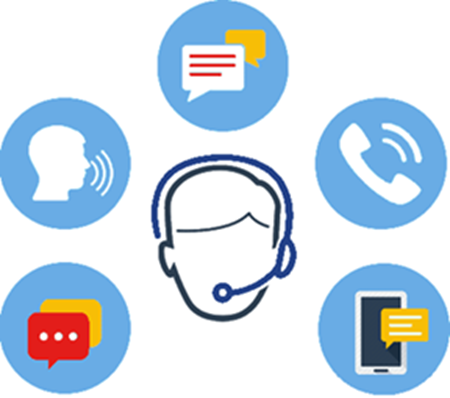This article summarizes some of the most common SmartReach services. The service that agents log in to controls the layout of the Agent Desktop, the different customer contact methods, the communication channels that are available, and the termination (or disposition) codes used to complete a customer interaction.
Services define the basic activities that agents can perform when they use a specific type of service. Agents can switch services while logged in if their account can access multiple services.
Common Service Types for Agents
The most common types of services used for agent interactions are described below.
Basic
Basic is a blended multi-channel service that supports a variety of automated inbound and outbound interactions including:
- Outbound and inbound voice.
- Attended automated voice campaigns.
- Automated and inbound email and Short Message Service (SMS) mobile phone campaigns.
- Bi-directional email, SMS, and chat communication.
- Click-enabled voice, email, and SMS interactions on CRM Agent Desktops.

The Basic service runs through SmartReach's automated queues and does not support the following features:
- Preview All campaigns.
- Human Call Initiator (HCI) or 10-Digit Manual with Transfer (10-DMT) campaigns.
- Unattended voice campaigns.
- Whisper voice campaigns.
When you select the Basic service, the following features are activated:
- The value in the Call Direction field is Blended and the field is disabled.
- The Inbound tab appears.
- The Inbound Phone Number table appears on the Phone Numbers tab.
- When you attempt to upload a campaign, only the following values appear in the Upload Campaign window:
- Messaging
- Outbound
-
SMS

Human Call Initiator (HCI)
HCI is a service in which a Clicker agent manually launches outbound telephone calls by clicking each displayed number. If a customer answers the call, the call is routed to a Closer Agent, who speaks with the customer. This service is typically used when a company does not have a customer’s previous consent to contact them by telephone.

Manual
Manual is a human-initiated service in which an agent manually enters all 10 digits of a telephone number on a keypad to launch an outbound call, or the agent manually selects a phone number to launch a call from a CRM Agent Desktop. The same agent handles the call.
Typically, before launching a call, the agent searches for information about each customer from their records and links any information they receive to the customer's account number. Manual services can also receive inbound calls.

Preview/Preview All
Preview/Preview All is a human-initiated service that presents the telephone number to an agent who can choose to either click the number to launch the call or skip the number. The same agent handles the call.
When the customer record is presented to the agent, the agent is given a predefined interval in which to respond. Typically, agents consult their records before deciding to dial the presented telephone number, click Manual to enter a different contact number, or skip the call for the customer for the current day and move to the next record in the campaign.

Quick Connect
A Quick Connect service is an automated outbound service that immediately connects live answers with an available agent. This service automatically connects outbound calls (if answered) to an agent. This service is typically used for campaigns where the customers previously have consented to be contacted by telephone.

Additional Service Types
In addition to the services that commonly support agents, SmartReach offers the following service types.
10 Digit Manual with Transfer (10DMT)
A 10DMT service is a human-initiated service in which an agent must manually enter all ten digits of a telephone number on the keypad to launch a call. The agent cannot copy and paste any numbers into the keypad. If the agent enters an incorrect number, the number is ignored and the screen remains unchanged until the agent enters the correct number. The call is launched when the agent enters the correct number. If a customer answers the call, the call is routed to the Closer Agent, who speaks with the customer. The HCI service is recommended for this activity.
API Enabled
API Enabled is a service that allows an agent to manually dial using the required desktop Application Programming Interface (API) integrations. This service supports the manual dialing of desktop API integrations.
Human Text Initiator (HTI)
HTI is a service where a Clicker Agent can manually launch SMS messages using a predefined template.
Inbound
Inbound is a service that receives and directs callers using a designated Interactive Voice Response (IVR) system. Inbound services can route calls to agent teams, to certain outbound services using service groups, to themselves using service routing, to voicemail boxes, to a self-service IVR, or to a combination of these.
SMS
SMS is a high-capacity North American SMS that communicates with its outbound dialing systems. The service supports both standard rate and Free-to-End-User (FTEU) dedicated common short code (CSC), long code, and toll-free SMS services that have complete mobile carrier coverage in the United States and Canada.
Unattended
Unattended is an automated outbound service that immediately connects with an IVR system. Regardless of the responses provided, the called party cannot be connected to an agent.
Whisper
Whisper is also an automated outbound service that immediately connects with an IVR system. However, unlike the Unattended service, based on the responses provided, the called party can be connected to an agent through an inbound voice service. The RPC service is recommended for this activity.